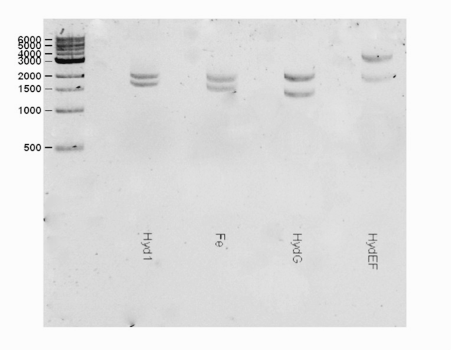Difference between revisions of "Part:BBa K1998011"
Ari edmonds (Talk | contribs) |
Ari edmonds (Talk | contribs) |
||
| Line 40: | Line 40: | ||
<br> | <br> | ||
<br> | <br> | ||
| − | Ferredoxin reductase (FNR)<br> | + | Ferredoxin NADP+ reductase (FNR)<br> |
Mass: 38.27 kDa<br> | Mass: 38.27 kDa<br> | ||
Sequence: <br> | Sequence: <br> | ||
Revision as of 10:33, 28 October 2017
Ferredoxin-FNR
Sequence and Features
- 10COMPATIBLE WITH RFC[10]
- 12COMPATIBLE WITH RFC[12]
- 21COMPATIBLE WITH RFC[21]
- 23COMPATIBLE WITH RFC[23]
- 25COMPATIBLE WITH RFC[25]
- 1000COMPATIBLE WITH RFC[1000]
Overview
The ferredoxin and ferredoxin reductase enzyme which are encoded by this part makes up the ferredoxin reductase operon for testing the hydrogen production pathway of our project. Oxidised ferredoxin is reduced by ferredoxin reductase using NADPH. The reduced ferredoxin supplies electrons to hydrogenase to allow the testing for hydrogen production with the hydrogenase operon in vivo in the absence of PSII. In the presence of PSII we plan to enable the direct transfer of electrons to the hydrogenase from PSII, similar to the proof of concept for PSII-hydrogenase coupling demonstrated in vitro [5].

Biology & Literature
Ferredoxin-NADP reductase (FNR) has a mass of 36kDa and shows ferredoxin-dependent cytochrome c reduction activity [1]. This enzyme facilitates electron transfer from ferredoxin to NADP [2]. In vivo studies showed that this protein is N-trimethylated on 3 different lysines – K135, K83 and K89). This modification is thought to be involved in regulation and structural modulation since the methylated protein is smaller and more compact. Studies comparing FNR protein from Chlamydomonas reinhardtii with recombinant protein expressed in E. coli showed that the latter had a higher Km value for NADPH [3].
PETF plays a role in transfer of electrons between photosystem I and FNR [4]. It has been shown to enhance heat stress tolerance when it is overexpressed in Chlamydomonas reinhardtii by downregulating the levels of reactive oxygen species.
Part Verification

Improved Characterisation
The Macquarie iGEM team of 2017 has further characterise the expression and function of the proteins in this part.

Protein information
Ferredoxin
Mass: 13.0 kDa
Sequence:
MAMRSTFAARVGAKPAVRGARPASRMSCMAYKVTLKTPSGDKTIECPADTYILDAAEEAGLDLPYSCRAGACSSCAGKVAAGTVDQSDQSFLDDAQMGNGFV
LTCVAYPTSDCTIQTHQEEALY
Ferredoxin NADP+ reductase (FNR)
Mass: 38.27 kDa
Sequence:
MQTVRAPAASGVATRVAGRRMCRPVAATKASTAVTTDMSKRTVPTKLEEGEMPLNTYSNKAPFKAKVRSVEKITGPKATGETCHIIIETEGKIPFWEGQSYGVIPP
GTKINSKGKEVPHGTRLYSIASSRYGDDFDGQTASLCVRRAVYVDPETGKEDPAKKGLCSNFLCDATPGTEISMTGPTGKVLLLPADANAPLICVATGTGIAPFRS
FWRRCFIENVPSYKFTGLFWLFMGVANSDAKLYDEELQAIAKAYPGQFRLDYALSREQNNRKGGKMYIQDKVEEYADEIFDLLDNGAHMYFCGLKGMMPGIQD
MLERVAKEKGLNYEEWVEGLKHKNQWHVEVY
References
[1] Decottignies, P., Lemarechal, P., Jacquot, J., Schmitter, J. and Gadal, P. (1995). Primary Structure and Post-translational Modification of Ferredoxin-NADP Reductase from Chlamydomonas reinhardtii. Archives of Biochemistry and Biophysics, 316(1), pp.249-259.
[2] Rogers, W., Hodges, M., Decottignies, P., Schmitter, J., Gadal, P. and Jacquot, J. (1992). Isolation of a cDNA fragment coding for Chlamydomonas reinhardtii ferredoxin and expression of the recombinant protein in Escherichia coli. FEBS Letters, 310(3), pp.240-245.
[3] Decottignies, P., Flesch, V., Gérard-Hirne, C. and Le Maréchal, P. (2003). Role of positively charged residues in Chlamydomonas reinhardtii ferredoxin-NADP+-reductase. Plant Physiology and Biochemistry, 41(6-7), pp.637-642.
[4] Lin, Y., Pan, K., Hung, C., Huang, H., Chen, C., Feng, T. and Huang, L. (2013). Overexpression of Ferredoxin, PETF, Enhances Tolerance to Heat Stress in Chlamydomonas reinhardtii. International Journal of Molecular Sciences, 14(10), pp.20913-20929.
[5] Mersch D., Lee C-Y., Zhang J.Z., BrinkertK., Fontecilla-Camps J.C., Rutherford A.W., and Reisner E. (2015) Wiring of Photosystem II to Hydrogenase for Photoelectrochemical Water Splitting J. Am. Chem. Soc., 137 (26), pp 8541–8549
